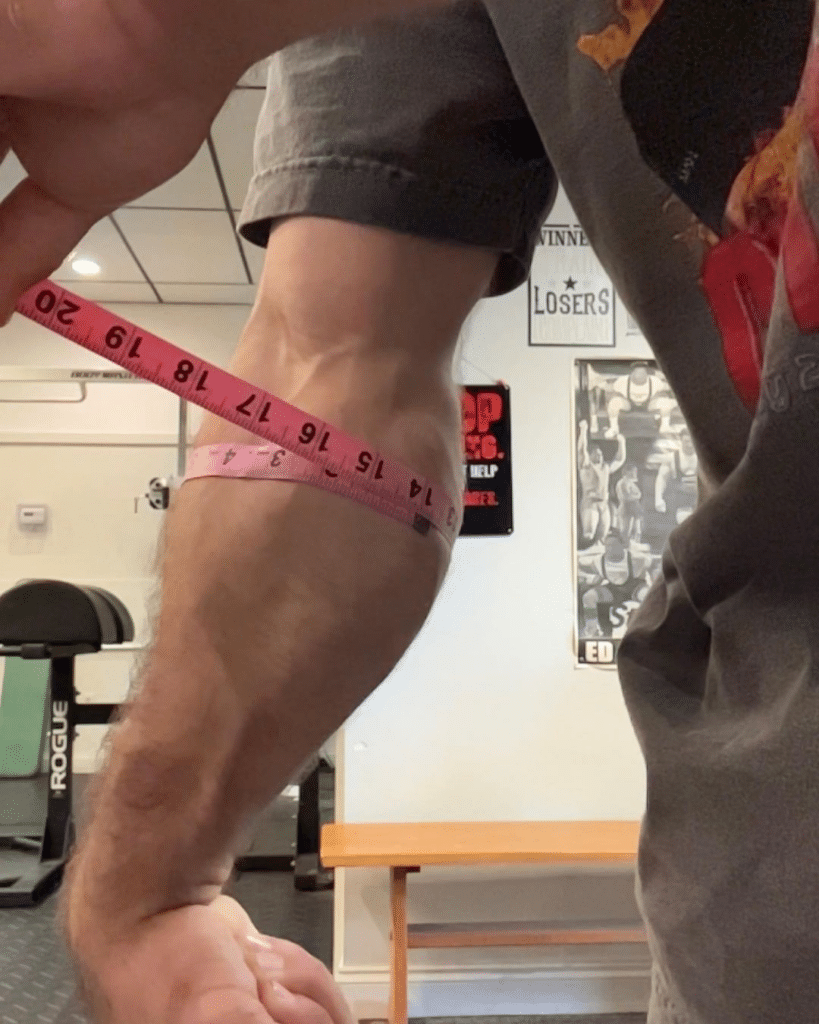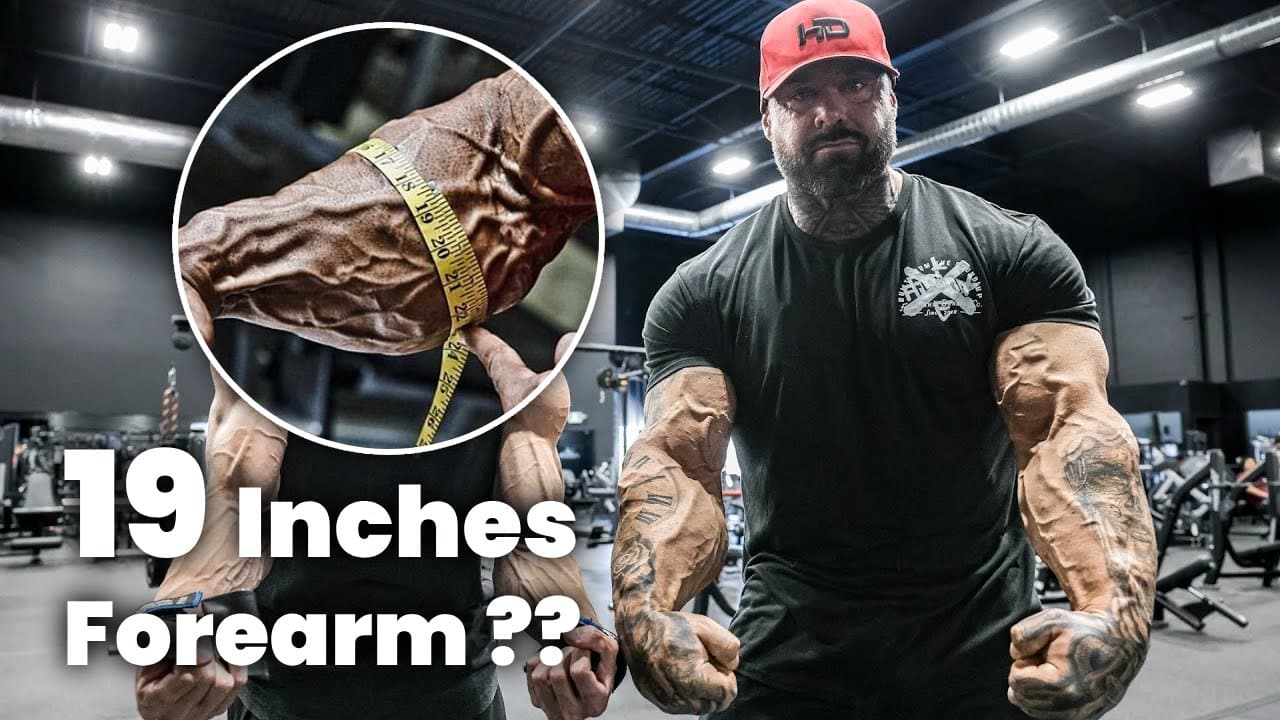Curious about what constitutes a “big” forearm?
Our comprehensive guide dives into the intricacies of forearm size, revealing surprising factors that shape these muscles.
Discover the percentile-based average sizes for both men and women, and the real impact of forearm strength on your overall fitness.
Related: Discover the average bicep, chest and calf size.
Jump to:
What Are Considered Big Forearms?
For men, a forearm circumference exceeding 14 inches is typically regarded as large (the average is 12.2).
In contrast, women with forearms measuring over 10.5 inches fall (the average is 10.3) into the same category.
These measurements, however, are not set in stone. They’re influenced by factors like height, body composition, and overall muscular development.
Factors Influencing Size
Forearm size is shaped by a blend of genetic, environmental, and lifestyle factors. Genetics play a foundational role, determining muscle composition and potential for growth. However, environment and lifestyle choices can significantly influence this natural blueprint. Regular strength training and specific forearm exercises can markedly increase muscle size.
Conversely, a sedentary lifestyle or lack of targeted exercise can lead to less pronounced forearm development. Nutrition also plays a crucial role; a balanced diet fuels muscle growth and repair.
A Word on Forearm Anatomy

The Forearms consist of two primary bones: the radius and the ulna. These bones support a symphony of muscles divided into two groups: the flexors and the extenders.
The flexors, residing on the palm side, are responsible for curling fingers and bending the wrist towards the forearm. The extenders, on the back of the forearm, facilitate straightening the fingers and wrist.
This musculoskeletal harmony allows for an array of movements, from gripping a barbell to executing a perfect pull-up. Understanding this anatomy is crucial for targeted training and injury prevention.
The Importance of Size and Strength
In the context of overall fitness, forearm size and strength play pivotal roles. Strong forearms enhance grip strength, which is fundamental in Crossfit and weightlifting. A firm grip translates to better control and efficiency in exercises like deadlifts, rows, and kettlebell swings.
Moreover, forearm strength contributes to wrist stability and health. This is vital not only in lifting weights but also in everyday activities. Neglecting forearm development can lead to imbalances and potential injuries.
Average Forearm Size For Men

| Percentile | Centimeters | Inches |
| 1ST | 26.3 | 10.35 |
| 2ND | 26.7 | 10.51 |
| 3RD | 27 | 10.63 |
| 5TH | 27.5 | 10.83 |
| 10TH | 28.3 | 11.14 |
| 15TH | 28.8 | 11.34 |
| 20TH | 29.1 | 11.46 |
| 25TH | 29.5 | 11.61 |
| 30TH | 29.8 | 11.73 |
| 35TH | 30.1 | 11.85 |
| 40TH | 30.4 | 11.97 |
| 45TH | 30.7 | 12.09 |
| 50TH | 31 | 12.2 |
| 55TH | 31.2 | 12.28 |
| 60TH | 31.5 | 12.4 |
| 65TH | 31.8 | 12.52 |
| 70TH | 32.1 | 12.64 |
| 75TH | 32.4 | 12.76 |
| 80TH | 32.8 | 12.91 |
| 85TH | 33.2 | 13.07 |
| 90TH | 33.8 | 13.31 |
| 95TH | 34.8 | 13.7 |
| 97TH | 35.4 | 13.94 |
| 98TH | 35.8 | 14.09 |
| 99TH | 36.5 | 14.37 |
This data provides a comprehensive overview of the average forearm sizes for men, measured in both centimeters and inches. It spans from the 1st percentile to the 99th percentile, offering a detailed insight into how forearm sizes vary among men.
- 1st to 5th Percentile (26.3 cm – 27.5 cm / 10.35 inches – 10.83 inches): This range represents the smaller forearm sizes. Men in this percentile have forearms that are significantly below the average.
- 10th to 25th Percentile (28.3 cm – 29.5 cm / 11.14 inches – 11.61 inches): This segment indicates below-average forearm sizes. Men within this range have slightly smaller than average forearms.
- 30th to 50th Percentile (29.8 cm – 31 cm / 11.73 inches – 12.2 inches): This is the mid-range, where forearm sizes are around the average. The 50th percentile (31 cm / 12.2 inches) is the median forearm size, representing the middle point of the distribution.
- 55th to 75th Percentile (31.2 cm – 32.4 cm / 12.28 inches – 12.76 inches): This range indicates slightly above-average forearm sizes. Men in these percentiles have larger than average forearms, but not by a significant margin.
- 80th to 95th Percentile (32.8 cm – 34.8 cm / 12.91 inches – 13.7 inches): This segment represents larger forearm sizes. Men in these percentiles have noticeably larger forearms than average.
- 97th to 99th Percentile (35.4 cm – 36.5 cm / 13.94 inches – 14.37 inches): This is the upper extreme, where forearm sizes are significantly above the average. Men in these percentiles have exceptionally large forearms.
Average Forearm Size For Women

| Percentile | Centimeters | Inches |
| 1ST | 22.5 | 8.86 |
| 2ND | 22.9 | 9.02 |
| 3RD | 23.2 | 9.13 |
| 5TH | 23.5 | 9.25 |
| 10TH | 24.1 | 9.49 |
| 15TH | 24.5 | 9.65 |
| 20TH | 24.8 | 9.76 |
| 25TH | 25.1 | 9.88 |
| 30TH | 25.4 | 10 |
| 35TH | 25.6 | 10.08 |
| 40TH | 25.9 | 10.2 |
| 45TH | 26.1 | 10.28 |
| 50TH | 26.3 | 10.35 |
| 55TH | 26.5 | 10.43 |
| 60TH | 26.8 | 10.55 |
| 65TH | 27 | 10.63 |
| 70TH | 27.3 | 10.75 |
| 75TH | 27.6 | 10.87 |
| 80TH | 27.9 | 10.98 |
| 85TH | 28.3 | 11.14 |
| 90TH | 28.7 | 11.3 |
| 95TH | 29.6 | 11.65 |
| 97TH | 30.3 | 11.93 |
| 98TH | 30.7 | 12.09 |
| 99TH | 31.3 | 12.32 |
This dataset offers a detailed view of average forearm sizes for women, measured in both centimeters and inches, across a range from the 1st to the 99th percentile. It provides insight into the variation in forearm sizes among women.
- 1st to 5th Percentile (22.5 cm – 23.5 cm / 8.86 inches – 9.25 inches): This range represents the smaller forearm sizes. Women in this percentile have forearms that are significantly below the average.
- 10th to 25th Percentile (24.1 cm – 25.1 cm / 9.49 inches – 9.88 inches): This segment indicates below-average forearm sizes. Women within this range have slightly smaller than average forearms.
- 30th to 50th Percentile (25.4 cm – 26.3 cm / 10 inches – 10.35 inches): This is the mid-range, where forearm sizes are around the average. The 50th percentile (26.3 cm / 10.35 inches) is the median forearm size, representing the middle point of the distribution.
- 55th to 75th Percentile (26.5 cm – 27.6 cm / 10.43 inches – 10.87 inches): This range indicates slightly above-average forearm sizes. Women in these percentiles have larger than average forearms, but not by a significant margin.
- 80th to 95th Percentile (27.9 cm – 29.6 cm / 10.98 inches – 11.65 inches): This segment represents larger forearm sizes. Women in these percentiles have noticeably larger forearms than average.
- 97th to 99th Percentile (30.3 cm – 31.3 cm / 11.93 inches – 12.32 inches): This is the upper extreme, where forearm sizes are significantly above the average. Women in these percentiles have exceptionally large forearms.
A Look At Different Bicep Sizes
To do
11.2 inches

13.75 inches

15 inches

18.5 inches

Can You Increase Forearm size?
Yes, you can increase forearm size through training. The muscles in the forearms respond to resistance training just like other muscles in the body. By engaging in specific exercises that target the forearm muscles, you can stimulate muscle growth and strength.
Multiple studies confirm this:
- High-intensity training, such as bench press exercises and various forearm flexion-extension exercises, has shown large effects in increasing the size of upper extremity muscles, including the forearm muscles. Specifically, isometric ulnar deviation training significantly increased the size of the flexor carpi ulnaris and radialis muscle size (Yagiz et al., 2022).
- Blood flow restricted exercise (BFRE) at low intensities can increase muscle strength as effectively as high-intensity training. In older adults, BFRE training increased forearm girth, suggesting an increase in muscle size (Kim et al., 2017).
- Isometric exercise increased the size of forearm veins in patients with chronic renal failure. This suggests that similar exercises could be effective in increasing forearm muscle size (Leaf et al., 2003).
How To Measure Your Forearm Circumference Correctly

Accurately measuring your forearm circumference is essential for tracking your fitness progress. To start, you’ll need a flexible tape measure. Stand with your arm extended and your palm facing upwards. Find the widest part of your forearm, usually about halfway between your elbow and wrist. Wrap the tape measure around your forearm without pulling it too tight or leaving it too loose. Record the measurement to the nearest quarter inch. It’s that simple!
How to Get Bigger Forearms
We have a whole article on how to train your forearms here.
Gaining size in your forearms isn’t just about the exercises you do; it’s also about how you do them and what else you’re incorporating into your routine. First, focus on increasing the intensity of your workouts.
This can mean upping the weight, but also increasing the number of repetitions or sets, or decreasing rest times between sets. Eccentric training, where you emphasize the lowering phase of an exercise, can also be incredibly effective for muscle growth.
Specific Exercises Targeting Forearms
When it comes to resistance training, specificity is key. Hammer curls are excellent for hitting the brachioradialis, a major muscle in the forearm. Similarly, wrist curls and reverse wrist curls directly target the flexors and extensors of the forearms. Incorporating grip strengtheners or using thicker bars can significantly challenge these muscles, leading to increased growth and strength.
Enhancing Your Arm Definition
To improve forearm muscle appearance, focus on both hypertrophy and endurance training.
Incorporate exercises like wrist curls, reverse wrist curls, and farmer’s walks into your routine. These movements target the intricate muscles in the forearms, promoting growth and definition.
Don’t forget the importance of overall arm strength; exercises that work the biceps and triceps indirectly benefit forearm development. Consistency is key here – regular training combined with proper nutrition will yield the best results.
Increase Forearm Vascularity
Enhancing forearm vascularity, or the prominence of veins, is a coveted goal for many fitness enthusiasts. Achieving this requires a combination of low body fat and increased muscle mass. Incorporating exercises that promote blood flow to the forearms, such as high-repetition wrist curls and reverse curls, can be effective. Hydration is also key, as well-hydrated veins are more prominent. Additionally, temporary vascularity can be achieved through heat exposure or exercises that temporarily increase blood pressure to the arms.
Cardio Workouts and Their Impact on Arm Size
Cardio is often pigeonholed as a calorie burner, but its impact on forearm size is noteworthy. Activities like rowing or boxing can significantly engage and tone the forearm muscles. While cardio may not directly increase muscle size like resistance training, it enhances vascular health, leading to better endurance and performance during strength exercises.
FAQs on Forearm Size
How Do I Make My Forearms Bigger?
To make your forearms bigger, focus on exercises that specifically target the muscles in this area. This includes wrist curls, reverse wrist curls, hammer curls, and grip exercises. Increase the weight and intensity of these exercises over time for continuous muscle growth. Don’t forget to complement your workout routine with adequate protein intake and rest for muscle recovery and growth.
What is the Number 1 Forearm Exercise?
Arguably, the number one forearm exercise is the wrist curl. This exercise directly targets the muscles in your forearms and can be performed with a variety of weights like dumbbells or a barbell. To execute, sit with your forearms on your knees or a flat surface, palms up, and curl the weight towards your body, flexing at the wrist. For balanced development, incorporate reverse wrist curls as well.
How Do You Fully Train Forearms?
Fully training your forearms involves a combination of exercises that work all the muscles in the area. This includes flexor muscles, extensor muscles, and the brachioradialis. A comprehensive routine should include wrist curls, reverse wrist curls, hammer curls, and farmer’s walks. Additionally, exercises that enhance grip strength, such as dead hangs and grip squeezes, are beneficial.
Can I Strengthen My Forearm?
Absolutely! Strengthening your forearms is possible with consistent and targeted exercises. Incorporate a mix of weight lifting, gripping exercises, and flexibility routines to improve strength. Pay attention to your overall nutrition and hydration as they are vital in supporting muscle strength and recovery. Remember, progress takes time, so be patient and consistent with your training regimen.














